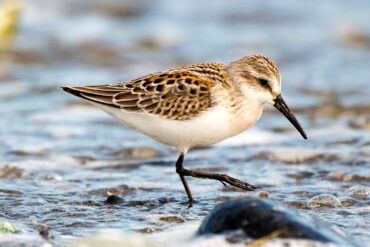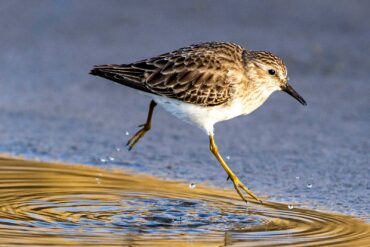
Birds are fascinating creatures that can be found in almost any place. Species have adaptations for their lifestyles and may differ considerably from other genres. For example, penguins and hummingbirds have little in common. Woodpeckers and albatrosses are worlds apart.
Even within some groups, there are surprising differences, particularly with shorebirds. Some are large and some are small. There are shorebirds with long bills, short bills and every length in between.
Birders enjoy sorting through mixed flocks of shorebirds to see how many individual species are present. One family of shorebirds is particularly challenging to differentiate. Small sandpipers appear to all look the same, especially in poor lighting or from a distance. In such conditions, birders may take the easy way out and simply record them as “peep species” on their lists.
Peep is the simplified term for multiple species of small sandpipers in the genus Calidris that are similar in appearance and often feed together on mudflats. The category gets its name from the “peep” sound made by the small shorebirds as they feed together and fly in tight flocks of hundreds or thousands of birds.

In North America, the five species of peeps are white-rumped, Baird’s, semipalmated, western and least sandpipers. All are long-distance migrants that breed in or near the Arctic, with many overwintering thousands of miles away in South America.
The white-rumped sandpiper is an East Coast migrant. The Baird’s and semipalmated sandpipers pass through Washington in mid to late summer on their journey to South America. Small numbers of individuals make refueling stops along estuaries and shorelines of Puget Sound and Hood Canal. Baird’s and semipalmated sandpipers are most often seen in August along the beaches around Hansville at the north end of the Kitsap Peninsula.
In western Washington, the most commonly observed peeps are the western and least sandpipers, which are usually seen on mudflats at low tide, as well as cobblestone shorelines and sandy beaches. Both species are fairly common around West Sound from July to early October. Small flocks spend the winter months along the outer coast of southern Washington, often feeding alongside large flocks of dunlin, a sandpiper that is slightly bigger than peeps.
In direct light from close range, the western and least sandpipers are relatively easy to differentiate. The most obvious field mark to look for is the leg color, which is black on the westerns and yellow on the leasts. But when the birds’ legs are covered in mud, it becomes a greater challenge to tell them apart. Other differences to look for are the western sandpiper’s pale body with reddish tones on the head and shoulders, as compared to the least sandpiper’s full body tones of brown mixed with white.
Both species sport a long, black bill that is used to probe into mud and sand for aquatic invertebrates. Females have longer bills, which on western sandpipers are slightly decurved at the tip.
The least sandpiper has the broadest summer range of North America’s five peep species. It breeds farther south than its cousins, in an area that encompasses Alaska and the northern Canadian mainland.
In contrast, the western sandpiper has a much more limited summer range. It breeds in the most remote regions of Alaska, including the northernmost coast and the Aleutian Islands.
Both western and least sandpipers have similar nesting habits. The male prepares a simple scrape on the ground, which the female finishes by lining it with grass, leaves or moss. Both parents incubate a clutch of four eggs for about three weeks. The young leave the nest within a day of hatching and can immediately feed themselves. The male assumes responsibility for the newly hatched chicks until they can fly in another three weeks.
As long-distance flyers, peeps are vulnerable to losing critical feeding areas along migration routes due to pollution or destruction from human activity. While least sandpipers spread out during migration, western sandpipers travel in massive flocks, with a high percentage of the entire species’ population visiting the same refueling areas each year. The Western Hemisphere Shorebird Reserve Network has designated the protected mudflats of the Grays Harbor National Wildlife Refuge, near Hoquiam, Washington, as a stopover of “hemispheric significance.” Each year, about a million migrating shorebirds pass through the area, and many of them are western sandpipers.
The annual Grays Harbor Shorebird and Nature Festival in Hoquiam (shorebirdfestival.com) celebrates the amazing journey taken by migrating shorebirds. Usually taking place the first weekend of May, it’s a collaboration of local organizations that offers guided bird walks at the refuge and other fun activities for nature lovers of all ages.
Everyone’s life is an odyssey. For small sandpipers, called peeps, the journey is long and sometimes fraught with dangers. A glimpse into their world reminds us that we share the planet with myriad incredible creatures.



























